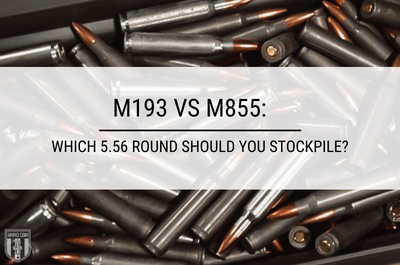You’ve already decided which rifle to purchase. Now you need to know which 5.56 ammo to feed it. M193 vs M855 (aka “green tip” ammo).
The M193 vs. M855 debate boils down to these points. M193 ammo is the better choice to buy in bulk, as it is less expensive and offers solid performance out to 500 yards. M855 green tip ammo offers better penetration and is slightly more accurate at longer distances. The M855 bullet also contains steel, and is therefore prohibited at many commercial gun ranges.
If you’re ready to load your mags with either of these amazing 5.56 cartridges, make sure to check out our bulk 5.56 ammo offerings. Otherwise, keep reading to learn why M193 ammo is my preferred choice.
Key Differences Between M855 and M193
| M193 | M855 (Green Tip) | |
|---|---|---|
| Weight | 55 grains | 62 grains |
| Muzzle Velocity | ~3,215 fps | ~3,060 fps |
| Muzzle Energy | ~1,262 ft-lbs | ~1,637 ft-lbs |
| Penetration Ability | Normal for an FMJ | Enhanced due to FMJ’s partial steel core |
| Applications | Target shooting, training, and defense | Target shooting, training, and SHTF situations |
| Affordability | Very affordable (especially in bulk) | Slightly more expensive, but still affordable |
M193 Ammo History
The M193 cartridge was developed in the early 1960s. It was formally adopted by the U.S. military for its new M16 rifle in 1964.
Initially developed as the 223 Remington, the new military ammo was designed to fire a 55 grain full metal jacket (FMJ) boat tail projectile at a muzzle velocity of 3,250 fps, and have maximum chamber pressure of 55,000 psi.
The 223 Rem round was designated “Cartridge, 5.56mm ball, M193” upon its adoption in 1964.
The M193 saw its first action in the jungles of Vietnam. It remained our frontline battle cartridge until the late 1980s, when the military switched to M855 ammo (more on that in a moment).
The M193 cartridge is sealed at its case mouth and primer pocket for improved moisture resistance. The primer pocket is also metallically crimped in place to prevent primers from backing out (and potentially striking the shooter’s eye) during automatic fire.
Early M16s had a relatively slow 1:12 barrel twist rate, which stabilizes a 55 grain bullet extremely well. In general, the M193 round is stabilized effectively in barrels ranging between a 1:9 to 1:12 twist rate, and reaches its full muzzle velocity potential from a 20" barrel.
M193 Specs
One of the major benefits of the 55 grain projectile is its propensity to yaw and fragment when it encounters soft tissue. The bullet fragments inflict serious trauma whilst simultaneously mitigating the risk of over-penetration.
However, there are some downsides to the M193.
Bullet fragmentation was not always observed on the battlefield, with many soldiers reporting their bullets merely passing through enemy combatants. This presented a serious issue, as the M193 round’s narrow projectile’s terminal performance is significantly less injurious without fragmentation.
Another issue was the bullet’s tendency to deflect when it encountered barriers like thick clothing or vegetation (I hear there’s a lot of the latter in Vietnam). Overall, M193 is not very effective at penetrating barriers and is ineffective against modern body armor. This wouldn’t have been a major problem while fighting unarmored Viet Cong soldiers, but modern militaries issue ballistic plates and helmets which the M193 is ill-equipped to handle.
This is where the M855 comes in.
M855 Ammo History
Tensions were high between the USSR and United States/NATO after the Vietnam War. Conflict seemed inevitable, which led the NATO alliance to sign a treaty replacing the 7.62x51mm (308 Winchester) with a smaller, lower-recoil cartridge in 1970.
FN Herstal took up the task of creating a new round, using the M193 as a starting point. What they developed came to be known as “M855” to the U.S., and “SS109” to other NATO members.
Often referred to as “green tip ammo,” M855 bullets have bimetal cores: lead in back, steel in front. Their jacketed tips are painted green to facilitate identification by soldiers on the battlefield.
M855 ammo has been NATO and the U.S. military’s primary intermediate combat cartridge since 1980. On paper, the M855 rounds sound like a massive upgrade over M193. However, battlefield reports from the First Gulf War and Somalia paint a different picture.
Soldiers on the front lines often reported M855 ammo being ineffective against enemy soldiers. This has been mostly attributed to the M855’s inability to fragment when it impacts soft targets.
Although the M855 bullet’s steel “penetrator” tip promotes more effective penetration through barriers, it was discovered that the bullet often passes straight through its target, inflicting a small wound channel as a result. Soldiers reported enemy combatants taking multiple shots of M855 and still not going down.
Those lackluster terminal ballistics sparked the development of a variety of new AR-15 cartridges during the early 2000s. The military eventually settled on the M855A1, which we will discuss in an upcoming section.
Continue reading M193 vs M855: Which 5.56 Round Should You Stockpile? on Ammo.com
